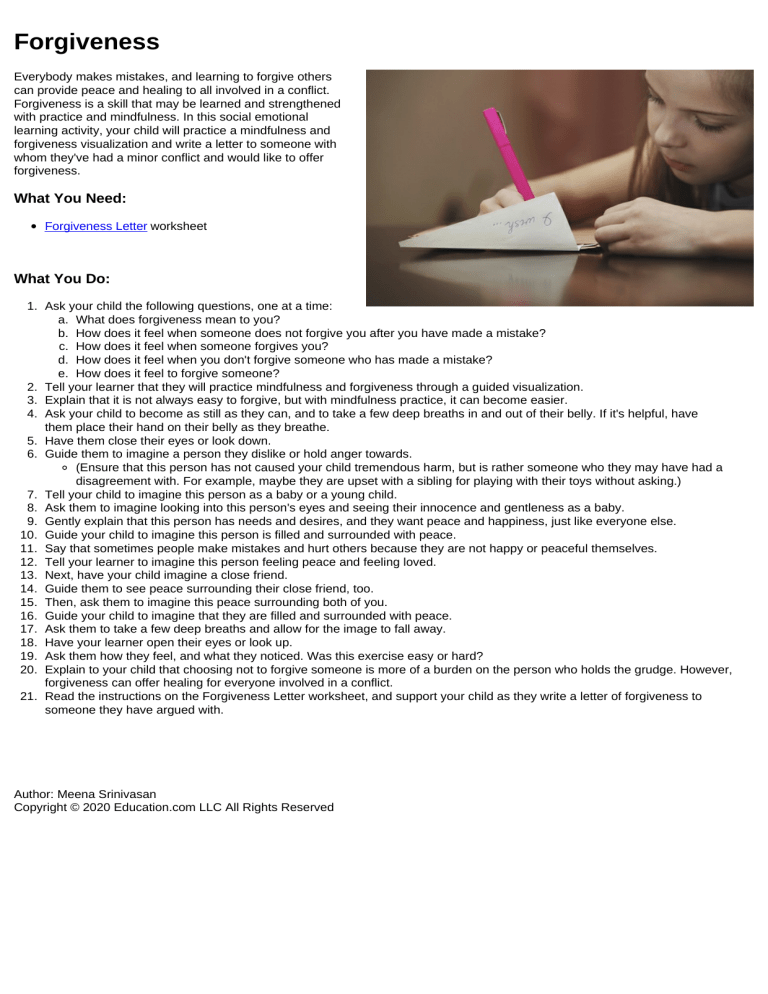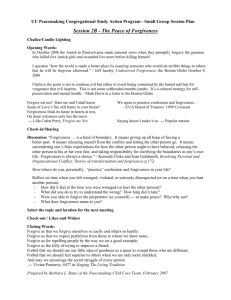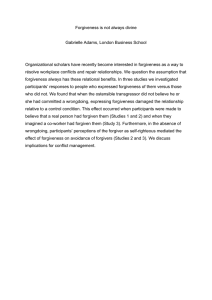
Forgiveness Everybody makes mistakes, and learning to forgive others can provide peace and healing to all involved in a conflict. Forgiveness is a skill that may be learned and strengthened with practice and mindfulness. In this social emotional learning activity, your child will practice a mindfulness and forgiveness visualization and write a letter to someone with whom they've had a minor conflict and would like to offer forgiveness. What You Need: Forgiveness Letter worksheet What You Do: 1. Ask your child the following questions, one at a time: a. What does forgiveness mean to you? b. How does it feel when someone does not forgive you after you have made a mistake? c. How does it feel when someone forgives you? d. How does it feel when you don't forgive someone who has made a mistake? e. How does it feel to forgive someone? 2. Tell your learner that they will practice mindfulness and forgiveness through a guided visualization. 3. Explain that it is not always easy to forgive, but with mindfulness practice, it can become easier. 4. Ask your child to become as still as they can, and to take a few deep breaths in and out of their belly. If it's helpful, have them place their hand on their belly as they breathe. 5. Have them close their eyes or look down. 6. Guide them to imagine a person they dislike or hold anger towards. (Ensure that this person has not caused your child tremendous harm, but is rather someone who they may have had a disagreement with. For example, maybe they are upset with a sibling for playing with their toys without asking.) 7. Tell your child to imagine this person as a baby or a young child. 8. Ask them to imagine looking into this person's eyes and seeing their innocence and gentleness as a baby. 9. Gently explain that this person has needs and desires, and they want peace and happiness, just like everyone else. 10. Guide your child to imagine this person is filled and surrounded with peace. 11. Say that sometimes people make mistakes and hurt others because they are not happy or peaceful themselves. 12. Tell your learner to imagine this person feeling peace and feeling loved. 13. Next, have your child imagine a close friend. 14. Guide them to see peace surrounding their close friend, too. 15. Then, ask them to imagine this peace surrounding both of you. 16. Guide your child to imagine that they are filled and surrounded with peace. 17. Ask them to take a few deep breaths and allow for the image to fall away. 18. Have your learner open their eyes or look up. 19. Ask them how they feel, and what they noticed. Was this exercise easy or hard? 20. Explain to your child that choosing not to forgive someone is more of a burden on the person who holds the grudge. However, forgiveness can offer healing for everyone involved in a conflict. 21. Read the instructions on the Forgiveness Letter worksheet, and support your child as they write a letter of forgiveness to someone they have argued with. Author: Meena Srinivasan Copyright © 2020 Education.com LLC All Rights Reserved

